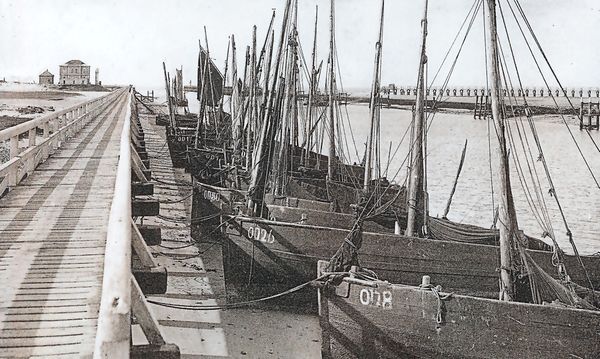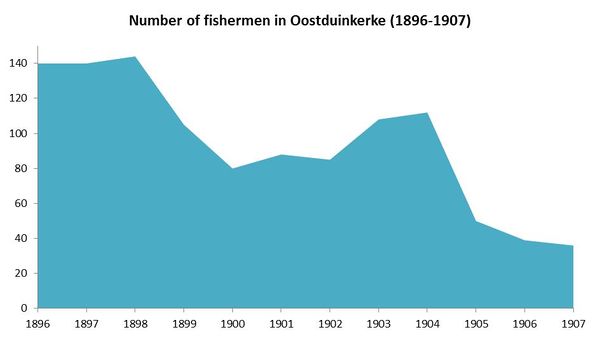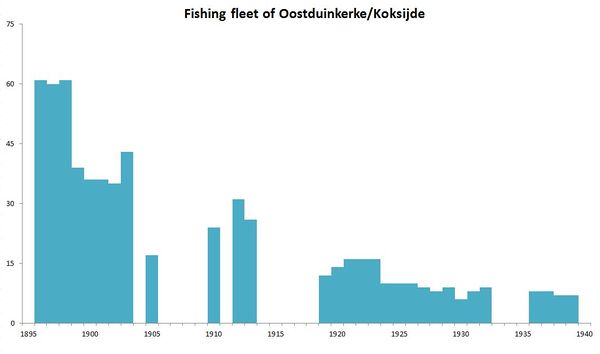Difference between revisions of "Fisheries in Oostduinkerke"
(→Fish shops and restaurants) |
(→Fish shops and restaurants) |
||
| Line 50: | Line 50: | ||
:'''Restaurant [http://www.dekorre.be/nl/specialiteiten-a-suggesties De Korre]''', situated close to the seawall of Oostduinkerke, serves specialties with fresh North sea fish such as shrimp, sole and monkfish according to market supply. | :'''Restaurant [http://www.dekorre.be/nl/specialiteiten-a-suggesties De Korre]''', situated close to the seawall of Oostduinkerke, serves specialties with fresh North sea fish such as shrimp, sole and monkfish according to market supply. | ||
| − | There are only a few fish shops in Oostduinkerke. In 2012 one of the most well known fish shops of Oostduinkerke, run by the family Messiaen, closed its doors after 75 years of activity <ref> [http://www.nieuwsblad.be/article/detail.aspx?articleid=DMF20120625_00199168 Article 'Het Nieuwsblad', June 26th 2012.]</ref>. With the closure of this shop, there are only two fish shops left, | + | There are only a few fish shops in Oostduinkerke. In 2012 one of the most well known fish shops of Oostduinkerke, run by the family Messiaen, closed its doors after 75 years of activity <ref> [http://www.nieuwsblad.be/article/detail.aspx?articleid=DMF20120625_00199168 Article 'Het Nieuwsblad', June 26th 2012.]</ref>. With the closure of this shop, there are only two fish shops left, [http://www.goudengids.be/vishandel-rudy-oostduinkerke-8670/ 'Rudy'] and [http://www.fishtrading.be/ 'Le Breton']. However, more fish shops can be found in Koksijde (click [https://www.google.be/maps/search/koksijde+viswinkel/@51.114190, 2.631020,13z here] for an overview). |
===<span style="color:#3a75c4; Font-size: 130%">'''<small>References</small>'''</span>=== | ===<span style="color:#3a75c4; Font-size: 130%">'''<small>References</small>'''</span>=== | ||
---- | ---- | ||
<references/> | <references/> | ||
Revision as of 09:46, 20 March 2014
Contents
Overview and Background
The Belgian coast is 67 km long and is entirely bordering the province of West-Flanders (region of Flanders, Belgium). The Belgian part of the North Sea is 3,457 km2 (0.5% of the North Sea area), of which more than 1/3 or 1,430 km² are territorial sea within 12 nautical miles distance of the coastline. Belgium currently has 10 coastal municipalities and 4 coastal ports (Nieuwpoort, Oostende, Zeebrugge and Blankenberge), and besides the fish auctions located in Oostende, Zeebrugge and Nieuwpoort where fish is sold according to legal procedures, there are no other dispersed landing points. Although historically the port and auction of Oostende was by far the most important, today the auctions of Zeebrugge (53%) and Oostende (45%) receive the largest share of the landings of Belgian fisheries in Belgian ports.
Belgium has a minor role in the European fisheries context with 0.35% of the total EU production of fish. In 2012, the Belgian commercial sea fishing fleet counted 86 ships, with a total engine capacity of 49,135 kW and gross tonnage of 15,326 GT [1]. 45 vessels are part of the Small Fleet Segment (max 221 kW engine power) of which 2 use passive gear. The remaining 41 vessels belong to the Large Fleet Segment and have an engine power between 221 kW and a maximum of 1,200 kW. This fleet segment represents approximately 80% of the engine power capacity and 77% of the GT of the fleet. While a smaller number use trammel nets (passive gear) and otter trawl, the largest share of the Large Fleet Segment are beam trawl vessels (≥662 kW). The Belgian fleet is highly specialized: more than 68% of the effort(days at sea) and 77% of total landings are achieved by beam trawlers(2010)focusing primarily on flatfish species such as plaice (Pleuronectes platessa) and sole (Solea solea). The results of the reconstruction of the Belgian fleet dynamics since 1830 are presented in Lescrauwaet et al. 2013[2].
The number of days at sea per vessel is fixed at a maximum of 265 per year and in 2011 the entire fleet realized a fishing effort of 15,855 days at sea. In 2011, the Belgian fleet landed a total of 20,138t, of which 16,905t were landed in Belgian ports. Plaice is the most important species in terms of landed weight. The landings of 2011 represented a value of €76.3 million, 14% of which was marketed in foreign ports. Sole generates 47% of the current total value of fisheries in Belgium. The Belgian sea fisheries represent 0.04% of the national Gross Domestic Product [3]. The main fishing grounds in terms of volume of landings in 2010 were in descending order: North Sea South (IVc), Eastern English Channel (VIId), North Sea Central (IVb), Southeast Ireland/Celtic Sea (VIIg) Bristol Channel (VIIf) and Irish Sea (VIIa).
In terms of direct employment, 439 fishers are registered of which approximately 350 are of Belgian nationality. Direct employment in fisheries represent approximately 0.5% of the total employment in the Belgian coastal zone. Another 1040 persons work in the fish processing industry and another 5000 persons in associated trade and services [1]. A historical overview of Belgian sea fisheries is available from [4] and [2].
The Belgian sea fishery sector is rather small compared to that of neighbouring countries in the North Sea and has been gradually losing importance since the Second World War. It is also gradually losing importance relative to the booming tourism industry in the Belgian coastal zone. However fisheries can be an added value to the tourism experience at the coast by developing fisheries-related tourism activities [5]. The present case study of Nieuwpoort (Belgium) analyzes how fisheries is embedded in tourism policy of the municipality.
Port description
Oostduinkerke (Geographical coordinates: 51°07'N 2°40'E) is a village situated at the Belgian west coast. It has a population of about 8.500 people and belongs to the municipality of Koksijde. The town was founded during the 12th century and was originally an agricultural village [6]. However, from the 18th century onwards and especially during the 19th century, Oostduinkerke transformed into a real fishermen’s town [7]. Most fishermen’s families settled in the dunes, where they combined their fishing activities with cultivating dune fields [8]. Many of the town’s fishermen were active on Dunkirk ships that went cod fishing in Icelandic waters, but beach and coastal fisheries were also important. Oostduinkerke used to have a substantial fleet of smaller vessels for inshore fishing. In 1895 for example, 24 ships were counted [9].
- Fig. 1. Part of the fishing fleet of Oostduinkerke (Collectie Daniël Moeyaert).
For a long time, Oostduinkerke even had its own port: the fishing vessels were moored to a pier in the harbour channel that originally belonged to the territory of Oostduinkerke. However, due to some border adjustments, from the 21st of June 1949 onwards, this channel became part of Nieuwpoort. During the 20th century, the Oostduinkerke inshore fisheries steadily declined and fishermen left the village to work in Nieuwpoort and Ostend [9]. Today, Oostduinkerke is still famous for its shrimp fishermen on horseback and on foot, who operate on the beach. This centuries-old tradition of beach fishing is a crucial part of the history of Oostduinkerke as a fishermen’s village. Although this type of fishing is no longer practiced by professional fishermen, it is still a very important part of the local folklore. Koksijde-Oostduinkerke is the only place in the world where you can still see shrimp fishermen on horseback and in December 2013, UNESCO recognized this unique tradition as intangible cultural heritage [10].
Fig. 2. An old image of shrimp fishermen on horseback in Koksijde. Today, this practice is recognized as intangible cultural heritage by UNESCO (© NAVIGO - Nationaal Visserijmuseum, Gemeente Koksijde).
Fishing Fleet
The number of fishermen in Oostduinkerke that were employed onboard of fishing vessels is illustrated in graph 1. Oostduinkerke reached the highest number of fishermen in 1898: at that time 144 fishermen were active. Afterwards, the number of fishermen started to decline [11].
- Graph 1: Number of ‘fleet' fishermen in Oostduinkerke (1896-1907) (Source: De Zuttere, 1909).
Oostduinkerke/Koksijde had a small number of inshore fishing fleet during the 19th and beginning of the 20th century. The highest number of fishing vessels in Oostduinkerke/Koksijde was recorded in 1896 with 61 fishing vessels, afterwards the fleet started to decline. In 1939 the number of ships had decreased to 7 inshore fishing vessels.
- Graph 2: Fishing fleet in Oostduinkerke/Koksijde (Source:1872-1903: ICES Fisheries Statistics = Bulletin Statistique des Pêches Maritimes 1903, 1905: De Zuttere (1909). Enquête sur la pêche maritime en Belgique, 1910: Von Schoen, F. (1912). La pêche maritime de la Belgique, 1928: Officieele lijst der visschersvaartuigen).
Fish shops and restaurants
Several restaurants are located in Oostduinkerke and Koksijde. Only a few of them are listed below.
- Next to the National Fisheries Museum NAVIGO in Oostduinkerke, the museum tavern ‘De Peerdevisscher’ is located. The tavern was rebuild based on the model of a fishermen’s inn from the 1920’s [12]. Johan and Corinne Casier, who come from a thoroughbred horseback fishing family, have run this pleasant popular little café since 2004. There is a limited menu, and at lunchtime you can eat fresh shrimp or wonderful North Sea sole with chips (only after a reservation) [13].
- Located 300 meters from the sea in Oostduinkerke, you can find the restaurant ‘t Zeilend Fornuis. The owners of this restaurant catch their own fresh shrimp twice a week, with the aid of an inflatable boat, a special net and a tractor. The fresh catch is immediately cooked and served in the restaurant, for example as part of the menu ‘Het Goud van Oosduinkerke’ (‘The Gold of Oostduinkerke’), which includes shrimp soup, shrimp croquettes, shrimp salad and stuffed potato with shrimp.
- Restaurant De Korre, situated close to the seawall of Oostduinkerke, serves specialties with fresh North sea fish such as shrimp, sole and monkfish according to market supply.
There are only a few fish shops in Oostduinkerke. In 2012 one of the most well known fish shops of Oostduinkerke, run by the family Messiaen, closed its doors after 75 years of activity [14]. With the closure of this shop, there are only two fish shops left, 'Rudy' and 'Le Breton'. However, more fish shops can be found in Koksijde (click 2.631020,13z here for an overview).
References
- ↑ 1.0 1.1 Roegiers, B.; Platteau, J.; Van Bogaert, T.; Van Gijseghem, D.; Bekaert, K.; De Bruyne, S.; Delbare, D.; Depestele, J.; Lescrauwaet, A.-K.; Moreau, K.; Polet, H.; Robbens, J.; Vandamme, S.; Van Hoey, G.; Verschueren, B. (2013). VIRA Visserijrapport 2012 Departement Landbouw en Visserij: Brussel. 98 pp.
- ↑ 2.0 2.1 Lescrauwaet, A.-K. (2013). Belgian fisheries: ten decades, seven seas, forty species: Historical time-series to reconstruct landings, catches, fleet and fishing areas from 1900. PhD Thesis. Ghent University (UGent): Gent. xiii, 242 pp.
- ↑ Anon. (2008). Strategische Milieubeoordeling van het Nationaal Operationeel Plan voor de Belgische visserijsector, 2007 - 2013. ILVO Visserij: Oostende. 103 pp.
- ↑ Lescrauwaet, A.-K.; Debergh, H.; Vincx, M.; Mees, J. (2010). Fishing in the past: Historical data on sea fisheries landings in Belgium. Mar. Policy 34(6): 1279-1289. dx.doi.org/10.1016/j.marpol.2010.05.006
- ↑ Anon. (2011). Europees Visserijfonds (EVF). AS 4: ontwikkelingsstrategie voor het Belgisch kustgebied. Europees Visserijfonds: (s.l.). 33 pp.
- ↑ Bijnens, B. (1974). Koksijde - Oostduinkerke: Kust-, strand- & paardevisserij. VVV Koksijde: Koksijde. 31 pp.
- ↑ Geschiedenis, Site Gemeente Koksijde, consulted on February 26th, 2014.
- ↑ Beun, A.-S.; Lanszweert, W.; Leerman, F.; Steevens, I. (2013). Op het ritme van de zee... het leven van een visser aan de Vlaamse kust, in: Steevens, I. et al. (Ed.) (2013). Zeevisserij aan de Vlaamse kust. pp. 26-51
- ↑ 9.0 9.1 Gyselinck, N.; Lanszweert, W.; Steevens, I.; Wolny, M. (2013). Kust- en zeevisserij, in: Steevens, I. et al. (Ed.) (2013). Zeevisserij aan de Vlaamse kust. pp. 114-165.
- ↑ Fishery Tradition, Site Gemeente Koksijde, consulted on February 26th, 2014
- ↑ De Zuttere, C. (1909). Enquête sur la pêche maritime en Belgique: introduction, recencement de la pêche maritime. Lebègue & cie: Bruxelles. 634 pp
- ↑ 'Estaminet De Peerdevisscher', Watererfgoed Vlaanderen, een zee van tradities.
- ↑ Friends and Partners, Site NAVIGO - Nationaal Visserijmuseum Oostduinkerke.
- ↑ Article 'Het Nieuwsblad', June 26th 2012.



